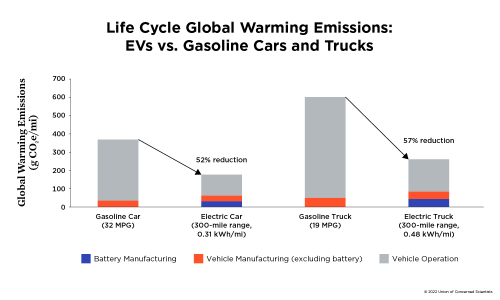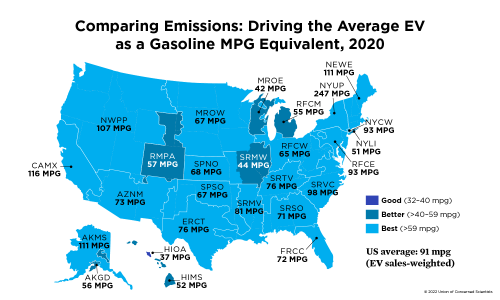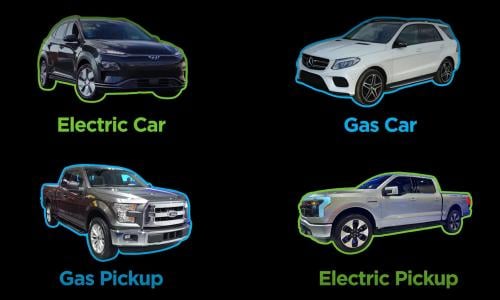Passenger cars and trucks are one of the largest sources of global warming emissions in the United States.
Electric vehicles (EVs) have the potential to dramatically reduce these emissions, especially when charged by low-carbon renewable electricity.
New UCS analysis finds that over its lifetime—from manufacturing to operation to disposal—the average new battery electric vehicle produces roughly half the global warming pollution than a comparable gasoline or diesel vehicle. Based on the most recently available data on power plant emissions and EV sales, driving the average EV in the United States produces global warming emissions equal to a gasoline vehicle that gets 91 miles per gallon.
To speed climate benefits and to encourage more drivers to choose electric vehicles, the report recommends policy changes and investments to bring even more renewable energy onto the grid, develop robust battery recycling programs to help reduce manufacturing impacts, and make EVs more accessible and affordable.
Driving Cleaner
This is a condensed, online version of the report. For all figures, references, and the full text, please download the full report PDF.
To reduce both climate-changing emissions and exposure to air pollution, the United States must greatly reduce tailpipe emissions from cars and trucks. This makes the transition to electric vehicles (EVs) vital to meeting targets for both climate and public health. Using fully electric vehicles in place of conventional gasoline- and diesel-powered vehicles enables the complete elimination of tailpipe emissions.
While electric vehicles can eliminate tailpipe emissions, the total emissions from their use include emissions from two other sources: the electricity used to recharge EVs and the processes and materials used to manufacture them. Thus, the value of switching from gasoline and diesel cars and trucks to EVs will increase further as the electricity grid and manufacturing become cleaner.
Global Warming Emissions from Driving Electric Vehicles
To assess the total global warming emissions from charging electric vehicles, the Union of Concerned Scientists (UCS) addresses all contributions from electricity production. These include:
- Emissions that result from raw-material extraction, such as coal mining and natural gas drilling;
- Emissions from delivering these fuels to power plants;
- Emissions from burning those fuels in power plants to generate electricity;
- Electricity losses that occur during distribution from power plants to the point where the electric vehicle is plugged in; and
- The efficiency of the vehicle in recharging and using electricity.
Similarly, our assessment of the global warming emissions from comparable gasoline and diesel vehicles addresses emissions that result from:
- Oil extraction at the well;
- Transporting crude oil to refineries;
- Refining oil into gasoline;
- Delivering fuel to gas stations; and
- Combusting fuel in the vehicle’s engine.
Because of differences in electricity generation across the United States, the emissions produced from driving the average EV vary depending on where the vehicle is driven (Figure ES-1). Considering the location of EV sales to date, the UCS assessment finds that:
- Everywhere in the United States, driving the average EV results in lower emissions than the average new gasoline vehicle.
- Over 90 percent of people in the United States live in regions where driving the average EV produces lower emissions than the most efficient gasoline vehicle on the market today (59 miles per gallon).
- Driving the average EV in the United States produces global warming emissions equivalent to those emitted by a gasoline car getting 91 miles per gallon.
- Driving the most efficient EV produces lower emissions than the most efficient gasoline car where 97 percent of the population lives—in other words, virtually everywhere in the United States.
- Everywhere in the United States, the emissions from driving an EV pickup truck are lower than those for the average new gasoline or diesel pickup truck.
While driving the average EV yields significant emissions savings, the more efficient the EV, the greater the benefits of switching from gasoline to electricity. For example, the emissions from driving a 2021 Tesla Model 3 Standard Range Plus in California equal those of a gasoline car getting 152 miles per gallon. The Tesla’s global warming emissions are a fifth of those of the average new gasoline car and over 60 percent less than even the most efficient gasoline car on the market.
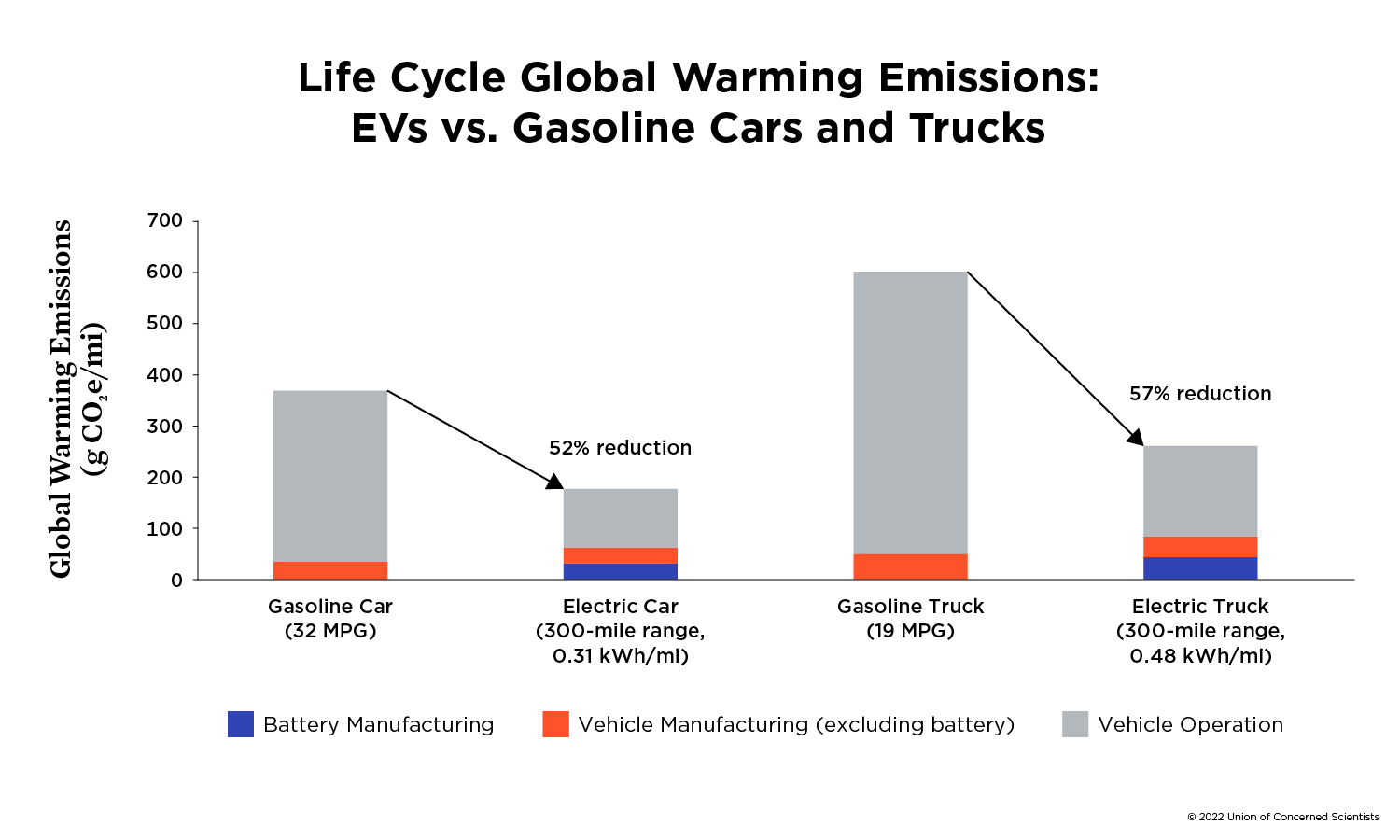
Note: Emissions are measured in grams of carbon dioxide–equivalent per mile, averaged over the life of the vehicle.
Global Warming Emissions from Manufacturing Electric Vehicles
Manufacturing an EV results in more global warming emissions than manufacturing a comparable gasoline vehicle. This is chiefly due to the energy and materials required to produce an EV’s battery. However, most of the global warming emissions over the lifespan of a vehicle occur during its use, so the reductions from driving an EV more than offset the higher manufacturing emissions. When comparing the average gasoline sedan (32 mpg) to the average-efficiency EV with a 300-mile-range battery, the EV reduces total lifetime emissions 52 percent. An EV pickup truck reduces lifetime emissions 57 percent compared with the average gasoline pickup (Figure ES-2).
Another way to understand how emissions savings from driving an EV offset additional manufacturing emissions is to consider the breakeven point: how far (or how long) an EV needs to drive for the savings to match the initial emissions “debt.” This breakeven point varies depending on regional electricity emissions. Based on where the US population lives, the mean breakeven point for an electric car with a 300-mile range compared with the average new gasoline sedan is 21,300 miles of driving, or 22 months based on average annual driving. Breakeven occurs more quickly, after about 17,500 miles (17 months), when comparing an electric truck (300-mile range) with the average new gasoline pickup truck.
Both EV cars and trucks are much cleaner than their gasoline counterparts, but electric trucks are responsible for more global warming emissions than electric cars simply because trucks are larger and heavier. Choosing the most efficient EV that meets mobility needs will minimize overall pollution. If a sedan meets a driver’s needs, that would be a better choice for the environment than a full-size SUV or a pickup.
The impacts of manufacturing EVs, including their batteries, extend beyond global warming emissions. Manufacturing processes and the sourcing of battery and other materials also affect water and air quality. Also, processes and sourcing can raise concerns over human rights and the ethical issues involved in mining and refining raw materials. This makes it essential to reduce the amount of raw materials needed to make EVs. In particular, reuse, remanufacturing, and recovery of materials from used batteries will help reduce these impacts.
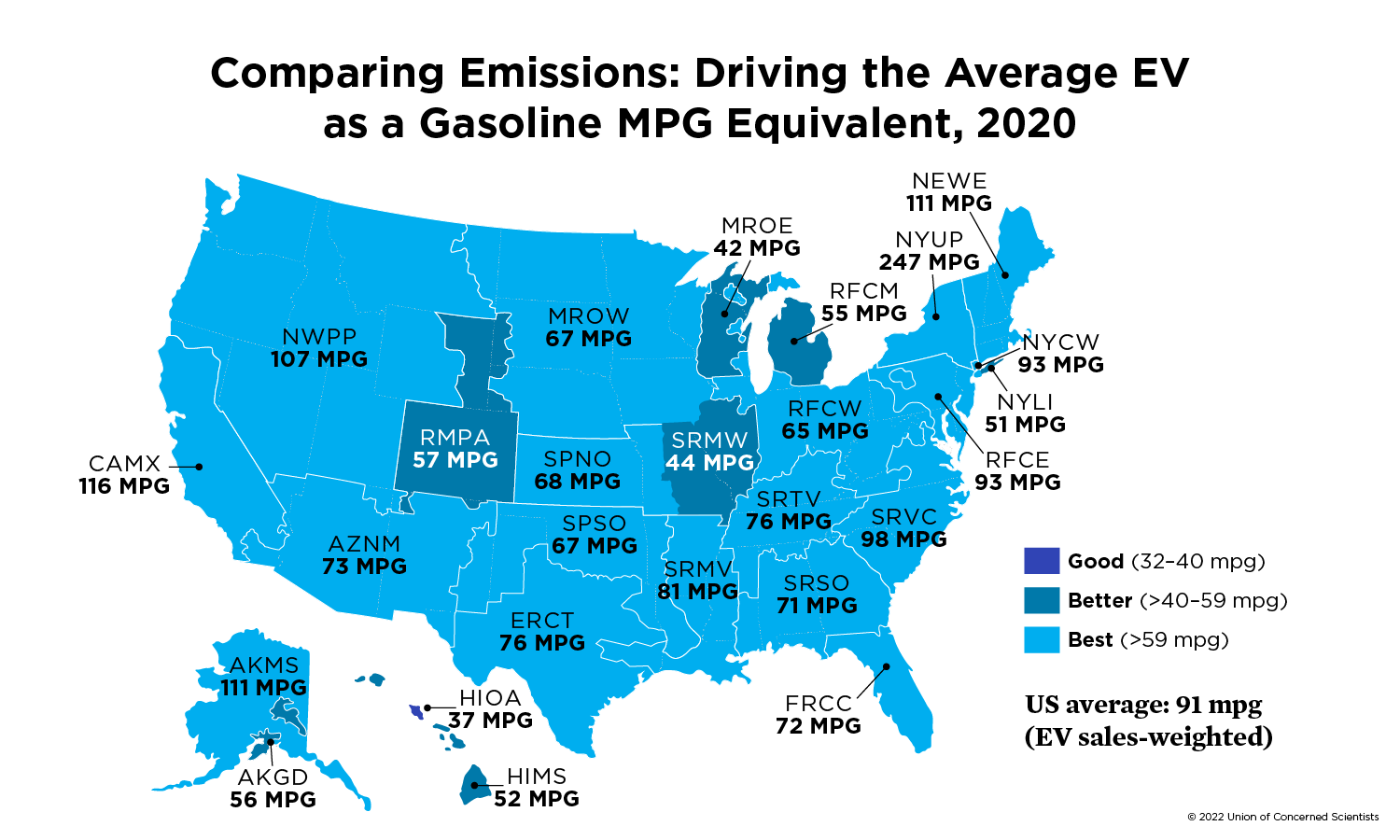
New York (NYUP), the emissions of the average EV compare with those of a gasoline-powered vehicle achieving 247 miles per gallon. Based on
where EVs have been sold in the United States, driving on electricity produces emissions equal to those of a gasoline car getting 91 miles per gallon.
Note: Acronyms refer to electricity grid regions as defined by eGRID (EPA 2022a).
Recommendations
To maximize emissions reductions and minimize negative manufacturing impacts, UCS recommends accelerating the transition to lower-emissions transportation through cleaner sources of electricity, improved vehicle manufacturing, and more efficient vehicles.
- Policymakers at all levels of government should adopt and strengthen policies and programs for increasing energy efficiency and deploying renewable energy. Reducing the emissions from generating electricity can reduce the emissions from driving and manufacturing EVs. Policy options include establishing renewable electricity standards, energy-efficiency resource standards, and incentives or mandates to improve grid operation, transmission, and resource planning.
- Governments and the private sector should invest more in research on both decreasing the global warming emissions associated with making EV batteries and improving the processes for recycling or reusing batteries.
- Policies should promote material circularity, in which materials reenter the supply chain when their use in the original product ends. Circularity includes encouraging materials recovery when a battery reaches the end of its life and using recovered materials in manufacturing. Offsetting the use of virgin materials can decrease the environmental and social impacts associated with mining.
- EV manufacturers should be responsible for sourcing materials ethically and sustainably throughout all steps in the supply chain. This means that their emissions and material sourcing must be transparent to the public and regulators.
- Public policies should ensure that manufacturers produce energy-efficient EVs. Policies also should encourage vehicle buyers to purchase the most efficient EVs that meet their mobility needs. The more efficient an EV, the smaller battery it needs to achieve a desired range capability, thereby reducing emissions from both driving and manufacturing.
- Policies, including funding, should support transportation options—including transit, shared mobility, and walking and biking infrastructure—that decrease the need for individual car ownership and limit the overall emissions from vehicle manufacturing and use.
- Vehicle incentives and infrastructure deployment should enable drivers across incomes and geographies to access EVs. To maximize the benefits of EVs, all drivers should be able to switch from gasoline and diesel vehicles.
Switching from conventional vehicles to electric vehicles reduces carbon emissions and smog-forming air pollution. To maximize these reductions, we must accelerate the adoption of EVs and transition to renewable electricity as quickly as possible. These dual transitions are a necessary part of putting the United States on a trajectory toward net-zero climate emissions by midcentury.
This is a condensed, online version of the report. For all figures, references, and the full text, please download the full report PDF.
Downloads
Citation
Reichmuth, Dave, Jessica Dunn, and Don Anair. 2022. Driving Cleaner: Electric Cars and Pickups Beat Gasoline on Lifetime Global Warming Emissions. Cambridge, MA: Union of Concerned Scientists. https://www.ucsusa.org/resources/driving-cleaner
